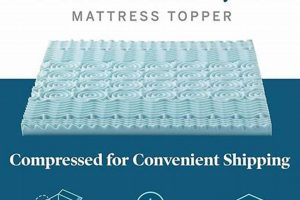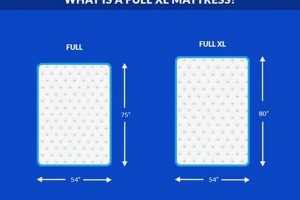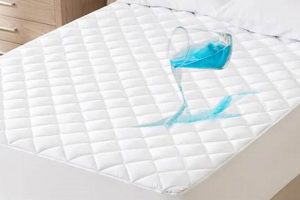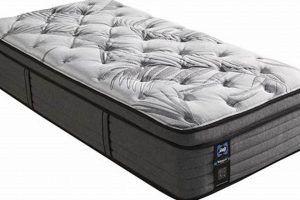A bed covering designed for a twin extra-long mattress, featuring a zipper closure, serves to encase the entire mattress. This enclosure provides a barrier against allergens, dust mites, bed bugs, and liquids. For instance, a student residing in a college dorm might utilize this type of covering to safeguard against potential allergens present in shared living spaces.
The value of a complete mattress encasement stems from its protective qualities. It contributes to a healthier sleeping environment by preventing the accumulation of irritants within the mattress fibers. Furthermore, it can extend the lifespan of the mattress by shielding it from spills and wear, thereby preserving its condition and potentially reducing the need for frequent replacements. These features offer both hygienic and economic advantages.
The following sections will delve into the specific material compositions of mattress encasements, various closure mechanisms beyond zippers, cleaning and maintenance procedures, and factors to consider when selecting the most appropriate mattress protection for individual needs.
Guidance on Mattress Protection
The subsequent recommendations are provided to optimize the selection and utilization of a full mattress encasement designed for a twin extra-long bed, particularly those featuring a zippered closure.
Tip 1: Material Composition: Prioritize encasements crafted from hypoallergenic materials. These materials mitigate the potential for allergic reactions, particularly for individuals with sensitivities to common allergens. Consider options such as organic cotton or microfiber.
Tip 2: Waterproofing Capabilities: Evaluate the degree of waterproofing offered. A completely waterproof encasement safeguards the mattress against spills and moisture damage, extending its lifespan and preventing the growth of mold and mildew.
Tip 3: Zipper Quality and Security: Inspect the zipper mechanism for durability and secure closure. A robust, well-constructed zipper ensures a complete and impenetrable seal, preventing the entry of dust mites and bed bugs. Look for zippers with locking features or protective flaps.
Tip 4: Breathability Considerations: Opt for an encasement that allows for adequate airflow. Breathable materials prevent the buildup of heat and moisture, contributing to a more comfortable sleeping environment. Features such as ventilated panels can enhance breathability.
Tip 5: Proper Installation Techniques: Adhere strictly to the manufacturer’s installation instructions. Ensure the encasement is fully and correctly positioned around the mattress to guarantee comprehensive protection.
Tip 6: Regular Maintenance Schedule: Establish a routine for laundering the encasement as per the manufacturer’s guidelines. Regular cleaning removes accumulated dust, allergens, and other contaminants, maintaining a hygienic sleep surface.
Tip 7: Size Verification: Before purchasing, confirm the encasements dimensions precisely match the dimensions of the twin extra-long mattress. An ill-fitting encasement will not provide adequate protection.
Adherence to these guidelines will facilitate the selection of a high-quality, effective mattress encasement, thereby safeguarding the mattress and promoting a healthier sleep environment.
The article will now transition to explore various brands and comparative analysis of similar products available in the market.
1. Allergen Barrier
The efficacy of a twin xl zippered mattress protector as an allergen barrier is directly related to its material composition and construction. The protector must create a physical barrier impermeable to common allergens such as dust mites, pet dander, pollen, and mold spores. The zipper closure is critical; if not properly sealed, it becomes a point of entry for allergens, negating the barrier’s effectiveness. For instance, if an individual with dust mite allergies uses a protector with a compromised zipper, they may still experience allergic reactions despite the presence of the protector.
The allergen barrier also extends to the protector’s capacity to prevent the accumulation of these allergens within the mattress itself. Mattresses, over time, can become reservoirs for allergens, exacerbating sensitivities and potentially triggering respiratory issues. A high-quality, zippered mattress protector confines allergens, preventing them from settling within the mattress fibers. Regular laundering of the protector further reduces allergen load and promotes a healthier sleep environment. Consider the example of a college dorm room where multiple students have occupied the same mattress; a reliable allergen barrier becomes particularly important.
In summary, the success of an allergen barrier in a twin xl zippered mattress protector hinges on both the material’s inherent barrier properties and the integrity of the zipper closure. The practical outcome is a reduction in allergen exposure, contributing to improved respiratory health and reduced allergic reactions. Challenges remain in ensuring consistent material quality and user compliance with proper installation and maintenance procedures. Effective allergen barriers are vital for maintaining sleep hygiene, particularly for individuals with sensitivities or allergies.
2. Waterproof Properties
Waterproof characteristics are a significant factor in the functional performance of a full mattress encasement, particularly those designed for twin extra-long beds with zippered closures. These properties dictate the encasement’s capacity to shield the mattress from liquid intrusion, preserving its structural integrity and hygienic condition.
- Barrier Against Spills and Stains
The primary function of waterproofing is to prevent liquids, such as water, bodily fluids, or accidental spills, from penetrating the mattress. This barrier safeguards against staining and the development of unpleasant odors. For example, a student residing in a dormitory might inadvertently spill a beverage; a waterproof encasement would prevent the liquid from soaking into the mattress, maintaining its cleanliness.
- Prevention of Mold and Mildew Growth
Moisture accumulation within a mattress can foster the growth of mold and mildew, posing health risks and degrading the mattress material. Waterproofing prevents this by creating a dry environment. A scenario where a mattress is exposed to high humidity, coupled with minor liquid spills, highlights the importance of this feature.
- Extended Mattress Lifespan
By preventing liquid damage, waterproof properties contribute to the longevity of the mattress. Frequent exposure to moisture can compromise the foam or internal structure of the mattress, leading to premature degradation. Waterproofing mitigates this risk, preserving the mattress’s support and comfort over an extended period.
- Hygienic Sleep Environment
Waterproof mattress protectors create a barrier against the accumulation of bodily fluids, such as sweat and saliva, which can harbor bacteria and contribute to unpleasant odors. Maintaining a dry and clean sleep surface is crucial for overall hygiene. In environments where mattresses are used by multiple individuals, such as in hotels or hospitals, this aspect is particularly important.
In summary, the waterproof attributes of a full mattress encasement are crucial for safeguarding the mattress from liquid damage, preventing mold and mildew growth, extending its lifespan, and ensuring a hygienic sleep environment. These properties are particularly relevant in scenarios involving potential spills, high humidity, or shared mattress usage. The effectiveness of the waterproofing depends on the material composition and construction of the encasement.
3. Zipper Integrity
Zipper integrity is a crucial element in the functionality and effectiveness of a twin xl zippered mattress protector. The zipper serves as the primary closure mechanism, ensuring complete encasement of the mattress and preventing the ingress of allergens, bed bugs, and fluids. Compromised zipper integrity undermines the protective capabilities of the entire encasement.
- Barrier Breach Prevention
A robust zipper is essential to maintain a complete barrier against potential contaminants. A faulty zipper, characterized by gaps, broken teeth, or a malfunctioning slider, allows allergens, bed bugs, and other unwanted elements to penetrate the encasement, defeating its purpose. For example, if the zipper fails to fully close, dust mites can readily enter the mattress, triggering allergic reactions in sensitive individuals. Similarly, bed bugs can exploit even minor openings to infest the mattress, leading to significant discomfort and necessitating costly eradication measures.
- Durability and Longevity
The zipper’s construction directly influences the lifespan of the mattress protector. A zipper made from substandard materials or with poor stitching is prone to breakage and separation, rendering the encasement unusable. Frequent use and laundering can exacerbate these issues. Therefore, the choice of materials, such as high-gauge metal or durable nylon, and the quality of stitching are critical for ensuring the zipper’s long-term functionality and the protector’s overall value.
- Ease of Use
A well-designed zipper facilitates easy installation and removal of the mattress protector. A smooth, snag-free zipper operation simplifies the process of encasing the mattress and removing the protector for washing. Conversely, a poorly designed or malfunctioning zipper can make installation and removal difficult and time-consuming, potentially leading to damage to the protector itself. Features like large zipper pulls and reinforced stitching around the zipper area enhance ease of use and contribute to the overall user experience.
- Secure Closure Mechanisms
Advanced zipper designs incorporate features such as locking mechanisms or overlapping flaps to further enhance security and prevent accidental openings. These features provide an additional layer of protection against contaminants and ensure that the mattress remains fully encased, even under stress. For example, a locking zipper prevents the accidental opening of the protector during sleep, while an overlapping flap shields the zipper from direct contact with the sleeper, enhancing comfort and preventing snagging.
In conclusion, zipper integrity is paramount to the effectiveness of a twin xl zippered mattress protector. A durable, well-designed zipper ensures complete mattress encasement, prevents barrier breaches, enhances ease of use, and extends the protector’s lifespan. Compromised zipper integrity can negate the protective benefits of the encasement, rendering it ineffective against allergens, bed bugs, and fluids.
4. Mattress Longevity
Mattress longevity, the duration a mattress maintains its structural integrity and functional performance, is directly influenced by the utilization of a twin xl zippered mattress protector. The protector acts as a physical barrier, mitigating factors that contribute to mattress degradation. For example, without a protector, a mattress is susceptible to spills, which can damage internal components and foster mold growth, thereby shortening its lifespan. Similarly, the accumulation of dust mites and body oils degrades materials, reducing support and comfort over time. The encasement slows or prevents these processes.
The protective encasement serves as an investment, reducing the frequency of mattress replacement. Consider a university dormitory scenario: unprotected mattresses, subject to frequent changes in occupants and varying levels of care, require replacement far more often than those encased in protectors. The zippered enclosure design provides comprehensive protection, ensuring that contaminants do not bypass the primary barrier. High-quality protectors, constructed from durable materials, withstand repeated laundering, maintaining their protective qualities over extended periods. This ensures consistent safeguarding against spills, allergens, and wear.
In summary, the correlation between mattress longevity and the use of a twin xl zippered mattress protector is significant. The protector extends the mattress’s lifespan by shielding it from common damaging elements. The economic and hygienic benefits of this protection are substantial, reducing replacement costs and promoting a cleaner sleep environment. The effectiveness of the protector hinges on material quality, proper installation, and regular maintenance; however, the fundamental principle remains that a protected mattress outlasts an unprotected one.
5. Proper Fit
The concept of proper fit is fundamental to the effective functioning of a twin xl zippered mattress protector. A mismatch between the protector’s dimensions and the mattress size compromises the protector’s ability to safeguard the mattress, potentially negating its intended benefits.
- Complete Encasement Security
A properly fitted twin xl zippered mattress protector ensures complete encasement of the mattress, leaving no exposed areas. This is critical for preventing allergens, bed bugs, and fluids from reaching the mattress. If the protector is too small, it may not fully enclose the mattress, leaving gaps. Conversely, if it’s too large, it can bunch up, creating stress points on the zipper and potentially leading to tearing. For instance, a protector that is several inches too short will not fully encase the foot of the mattress, creating a potential entry point for bed bugs.
- Optimal Protective Barrier
A snug fit maximizes the effectiveness of the protector as a barrier. When the protector fits correctly, it forms a smooth, taut surface that prevents liquids from pooling and seeping into the mattress. A loose fit allows liquids to accumulate in the folds of the protector, increasing the risk of penetration. This is particularly important for waterproof protectors, where a tight fit ensures that the waterproof membrane is in close contact with the mattress surface, providing optimal protection against spills.
- Extended Protector Lifespan
A correctly sized protector is less likely to experience undue stress and wear. An ill-fitting protector is subject to stretching, tearing, and zipper strain, reducing its lifespan. A protector that is constantly pulled and stretched to fit a larger mattress will degrade more rapidly than one that fits properly. For example, the zipper on an undersized protector may fail prematurely due to the constant tension. Proper fit contributes to the protector’s longevity, providing continued protection over an extended period.
- Enhanced Sleep Comfort
A well-fitted mattress protector minimizes noise and shifting, contributing to a more comfortable sleep environment. A loose protector can create crinkling sounds and shifting, disturbing sleep. A snug fit ensures that the protector remains in place, providing a smooth and quiet surface. This is particularly important for individuals sensitive to noise and movement during sleep. A properly fitted protector essentially becomes an imperceptible part of the mattress, enhancing sleep quality.
The facets of complete encasement, barrier effectiveness, longevity, and comfort underscore the significance of proper fit in relation to a twin xl zippered mattress protector. Ensuring that the protector accurately corresponds to the mattress dimensions is paramount for maximizing its protective capabilities and contributing to a cleaner and more comfortable sleep environment. The benefits of allergen protection, waterproofing, and extended mattress lifespan are all contingent upon achieving a proper fit.
Frequently Asked Questions
The following section addresses common inquiries regarding twin XL zippered mattress protectors, providing concise and informative answers to enhance understanding and facilitate informed purchasing decisions.
Question 1: What constitutes a “twin XL” mattress size, and why is it significant for protector selection?
A “twin XL” mattress measures approximately 39 inches in width and 80 inches in length. This dimension is prevalent in college dormitories and single-sleeper settings requiring extra length. Selecting a protector precisely matched to these dimensions is crucial for complete encasement and optimal protection. A standard twin protector will be too short.
Question 2: What are the primary benefits of a zippered closure versus other mattress protector fastening methods?
The zippered closure offers complete, 360-degree encasement, preventing ingress of allergens, bed bugs, and fluids. Other methods, such as elastic bands or fitted sheets, may leave gaps or are prone to shifting, compromising the protective barrier. A fully sealed zipper provides superior protection.
Question 3: How frequently should a twin XL zippered mattress protector be laundered to maintain hygiene?
The recommended laundering frequency is every one to two months, or more frequently if spills or accidents occur. Regular washing removes accumulated dust mites, allergens, and body oils, maintaining a sanitary sleep surface and prolonging the protector’s lifespan.
Question 4: What material characteristics are indicative of a high-quality, durable mattress protector?
Look for protectors constructed from hypoallergenic, tightly woven fabrics such as cotton, polyester blends, or microfiber. Waterproof protectors should incorporate a breathable, waterproof membrane, such as polyurethane. Reinforcement around the zipper area enhances durability. Tear resistance is key.
Question 5: Can a twin XL zippered mattress protector effectively mitigate the risk of bed bug infestations?
A high-quality, zippered protector designed specifically for bed bug protection, featuring a secure zipper closure and durable fabric, can effectively prevent bed bugs from infesting the mattress. The protector encases the mattress, denying bed bugs access to harborage. It’s also recommended to get a mattress encasement rated to protect you from bed bugs, dust mites and allergens.
Question 6: Does the use of a mattress protector alter the comfort or feel of the mattress itself?
A properly fitted, breathable mattress protector should not significantly alter the comfort or feel of the mattress. However, some materials may slightly affect the surface texture. Choosing a thin, breathable fabric minimizes any discernible change in mattress feel. It is also important to look for options with waterproof protection.
In summary, a twin XL zippered mattress protector provides essential protection against allergens, bed bugs, and spills, contributing to a cleaner and healthier sleep environment. Proper selection, installation, and maintenance are crucial for maximizing its effectiveness.
The following section will address various brands that are available for this particular mattress size.
Conclusion
The preceding analysis has underscored the multifaceted importance of the twin xl zippered mattress protector. Its role extends beyond mere surface covering, encompassing critical functions in safeguarding mattress integrity, promoting hygienic sleep environments, and mitigating allergen exposure. Key factors, including material composition, waterproof properties, zipper integrity, and proper fit, dictate the protector’s overall effectiveness and longevity.
The information presented should inform responsible selection and utilization of these protectors. Recognizing the significance of a properly chosen and maintained mattress protector contributes directly to enhanced sleep quality and long-term mattress preservation. Continued diligence in assessing product specifications and adhering to recommended care practices remains essential to realizing the full benefits of this protective measure.


![Best Twin XL Pillow Top Mattress [2024 Guide] Organic & Natural Mattress Buyer’s Guide: Non-Toxic Sleep Solutions Best Twin XL Pillow Top Mattress [2024 Guide] | Organic & Natural Mattress Buyer’s Guide: Non-Toxic Sleep Solutions](https://mattressworldpa.com/wp-content/uploads/2025/07/th-873-300x200.jpg)




